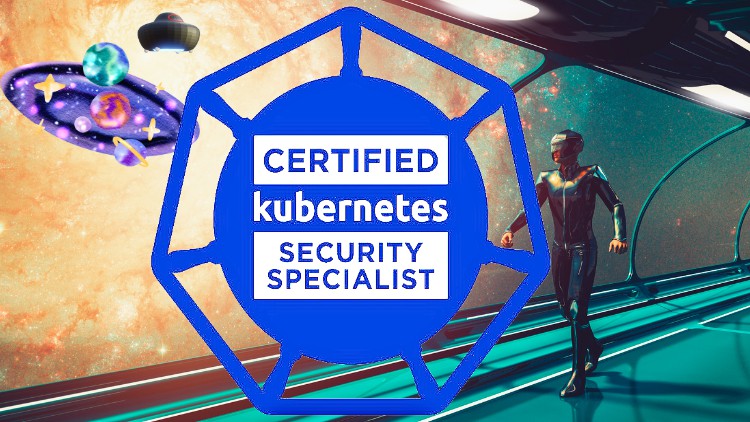
Certified Kubernetes Security Specialist Ultimate Preparation Guide Masterclass | Theory | Hands-on | Labs | Complete
What you will learn
Use Network security policies to restrict cluster level access
Use CIS benchmark to review the security configuration of Kubernetes components (etcd, kubelet, kubedns, kubeapi)
Properly set up Ingress objects with security control
Protect node metadata and endpoints
Minimize use of, and access to, GUI elements
Verify platform binaries before deploying
Restrict access to Kubernetes API
Use Role Based Access Controls to minimize exposure
Exercise caution in using service accounts e.g. disable defaults, minimize permissions on newly created ones
Update Kubernetes frequently
Minimize host OS footprint (reduce attack surface)
Minimize IAM roles
Minimize external access to the network
Appropriately use kernel hardening tools such as AppArmor, seccomp
Setup appropriate OS level security domains
Manage Kubernetes secrets
Use container runtime sandboxes in multi-tenant environments (e.g. gvisor, kata containers)
Implement pod to pod encryption by use of mTLS
Minimize base image footprint
Secure your supply chain: whitelist allowed registries, sign and validate images
Use static analysis of user workloads (Kubernetes resources, Docker files)
Scan images for known vulnerabilities
Perform behavioral analytics of syscall process and file activities at the host and container level to detect malicious activities
Detect threats within physical infrastructure, apps, networks, data, users and workloads
Detect all phases of attack regardless where it occurs and how it spreads
Perform deep analytical investigation and identification of bad actors within environment
Ensure immutability of containers at runtime
Use Audit Logs to monitor access
Description
Cluster Setup
- Use Network security policies to restrict cluster level access
- Use CIS benchmark to review the security configuration of Kubernetes components (etcd, kubelet, kubedns, kubeapi)
- Properly set up Ingress objects with security control
- Protect node metadata and endpoints
- Minimize use of, and access to, GUI elements
- Verify platform binaries before deploying
Cluster Hardening
- Restrict access to Kubernetes API
- Use Role Based Access Controls to minimize exposure
- Exercise caution in using service accounts e.g. disable defaults, minimize permissions on newly created ones
- Update Kubernetes frequently
System Hardening
- Minimize host OS footprint (reduce attack surface)
- Minimize IAM roles
- Minimize external access to the network
- Appropriately use kernel hardening tools such as AppArmor, seccomp
Minimize Microservice Vulnerabilities
- Setup appropriate OS level security domains
- Manage Kubernetes secrets
- Use container runtime sandboxes in multi-tenant environments (e.g. gvisor, kata containers)
- Implement pod to pod encryption by use of mTLS
Supply Chain Security
- Minimize base image footprint
- Secure your supply chain: whitelist allowed registries, sign and validate images
- Use static analysis of user workloads (e.g.Kubernetes resources, Docker files)
- Scan images for known vulnerabilities
Monitoring, Logging and Runtime Security
- Perform behavioral analytics of syscall process and file activities at the host and container level to detect malicious activities
- Detect threats within physical infrastructure, apps, networks, data, users and workloads
- Detect all phases of attack regardless where it occurs and how it spreads
- Perform deep analytical investigation and identification of bad actors within environment
- Ensure immutability of containers at runtime
- Use Audit Logs to monitor access
English
language
Content
Introduction
CKS Exam Strategy, Tips & Tricks
Trivy Introduction
Trivy – Scan Pods
Extract Secrets & Save to a File
gVisor Demo
CIS Benchmarks for Hardening a Kubernetes Cluster
Fix Dockerfile and Deployment.yaml for any security vulnerabilities
Enable Auditing
Falco
AppArmor
Gatekeeper or Open Policy Agent
PodSecurityPolicy
Fix Incorrectly Specified ServiceAccount in a Pod, Create Role, Rolebinding etc.
Fix Overly Permissive Permissions for Pod’s SA & Create SA, Role, Rolebindings
Scenario Based Question – Admission Controller – Image Scanner
Scenario Based Question – Network Policies – 1
Scenario Based Question – Network Policies – 2
Scenario Based Question – Verify Platform Binaries
Read Kubernetes Secrets from ETCD
Create & Secure an Ingress